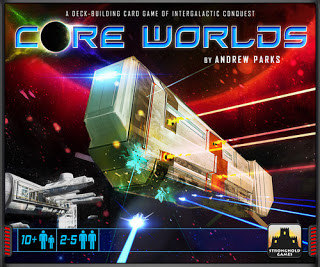 A bit of a departure this time; this is a review of a game that came out this year rather than one that I bought back in the 1970’s or 80’s, but which has quickly vaulted into the ranks of my favorites.
A bit of a departure this time; this is a review of a game that came out this year rather than one that I bought back in the 1970’s or 80’s, but which has quickly vaulted into the ranks of my favorites.
I had the opportunity this weekend to spend a few pleasant days with old friends playing board games. This is something of a ritual that my college buddy Bob has organized for the past 19 years at his house every Memorial Day weekend, and it’s usually the only time I get to see some gaming friends, and some of my own early D&D friends from my High School days, who have somehow become part of the group. All for the better. I went down with my daughter this time, and she had a grand time playing board games, she spent a lot of time with the other children there, and was also engrossed in video games and pinball. I, on the other hand, had a few games with me that I wanted to make sure I played. One of them was the new FFG version of WizWar, which was a hoot. The other was Stronghold Games‘ Core Worlds.
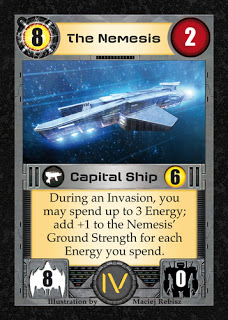 I bought Core Worlds at this year’s Dreamation convention after watching a game of it being played (I had, unfortunately, gotten to the con late that day and missed my spot to play). It is a deck-building game for 2-5 players that revolves around the dissolution of a mighty galactic empire as various barbarian empires from its periphery conquer planets and add various heroes, ships, and tactics to their repertoire to assist their invasions. It’s not a “collectible card game”; everything comes in the box, and there’s no need to buy boosters or any other “hamster-on-the-treadmill” gimicks. There is a supplement with more cards and rules coming out later this year, but it’s not necessary for play at all. The box claims it plays in 100 minutes, but our first outing was more than twice that; two hours seems a reasonable time for five players familiar with the game.
I bought Core Worlds at this year’s Dreamation convention after watching a game of it being played (I had, unfortunately, gotten to the con late that day and missed my spot to play). It is a deck-building game for 2-5 players that revolves around the dissolution of a mighty galactic empire as various barbarian empires from its periphery conquer planets and add various heroes, ships, and tactics to their repertoire to assist their invasions. It’s not a “collectible card game”; everything comes in the box, and there’s no need to buy boosters or any other “hamster-on-the-treadmill” gimicks. There is a supplement with more cards and rules coming out later this year, but it’s not necessary for play at all. The box claims it plays in 100 minutes, but our first outing was more than twice that; two hours seems a reasonable time for five players familiar with the game.
First, a word on the physical components; they are absolutely first-rate. The artwork is terrific and very evocative, by various different artists; the counters are thick and well-done, the cards solid, and the overall impression is that this is a game that could have come out of FFG (which I say as a complement). It retails for $45, and is well worth the price in terms of physical components.
The game play is an interesting twist on the deck-building mechanic that has become popular in recent years. Each player starts with a virtually identical deck of cards, and then is able to add to that deck by spending energy points. Cards in the deck are then spent in conquering planets, which not only add to one’s energy production (thus allowing the player to add to his card deck), but some of which grant victory points for the endgame and some special powers. What differentiates this game from others is the fact that each player is limited to the same number of actions each turn, and that direct player-vs.-player confrontation is not a feature.
The fact that each player is limited to the same number of actions means that no matter how awesome one’s deck of cards is, you still need to play them intelligently. You can’t just endlessly slap down cards until someone runs out; you need to plan ahead and figure out what you’re going to do in future turns.
The game is limited to 10 turns. As the game progresses, the units, planets, and other cards that become available become progressively more powerful (and, of course, expensive). A point of advice for those who play the game; don’t try to do things out of sequence. The turn sequence really matters, and is well-crafted to support the underpinning mechanics of the game.
The lack of direct player-on-player action is also something that I (uncharacteristically, for me), liked. There’s still an element of rivalry, as each player either recruits cards that are drawn or tries to conquer worlds. If I, for instance, thought that a given unit was particularly useful to another player, I might be tempted to swipe it out from under his nose. The same with planets; if I can see that player X only has 9 fleet points and 8 ground points of units deployed, I might well be inclined to conquer a world with those defenses, just to keep it out of another player’s hand. But there’s no direct “I’m going to attack your world” sort of action. The conquest is all on the ripe underbelly of the fading Galactic Empire, and I hope the designer resists the temptation to change that as inevitable supplements come out. It’s a feature that appeals to a lot of gamers, especially those weaned on Eurogames.
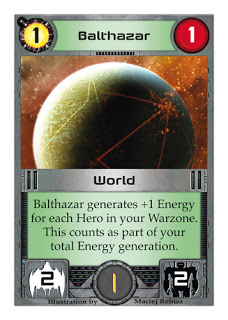 As with games like Magic: The Gathering, the cards are filled with lots of background that don’t have a lot of in-game utility, other than giving justification for the numbers on the card. But I have to say that I found the various cards and such very compelling; snub fighters (reminiscent of the original Star Wars film), Supreme Brain (which lets you draw more cards), and so forth really give you a sense for what the game’s implied universe is like, if you take the time to read through the text.
As with games like Magic: The Gathering, the cards are filled with lots of background that don’t have a lot of in-game utility, other than giving justification for the numbers on the card. But I have to say that I found the various cards and such very compelling; snub fighters (reminiscent of the original Star Wars film), Supreme Brain (which lets you draw more cards), and so forth really give you a sense for what the game’s implied universe is like, if you take the time to read through the text.
If you’re looking for a deck-building game that lets you choose from a large number of options, but yields real benefits for planning and strategy (as opposed to just assembling a deck full of the optimal cards and tossing them in rapid succession to overwhelm an opponent who doesn’t get lucky enough to draw the right cards), this is a terrific game. I’m going to be playing a lot of it in the coming months. Buy it here.
Full disclosure: I’ve known Steve Buonocore, president of Stronghold Games, for many years and consider him a friend. That said, I purchased the game on my own, and this review will come as a complete surprise to him.


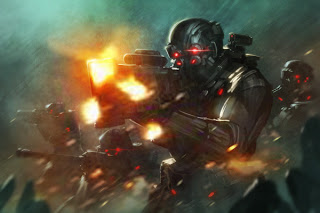
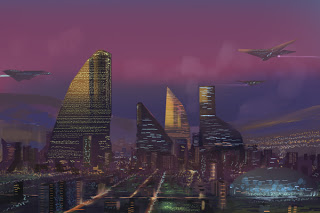







Thanks for the review. Hopefully they'll be at DexCon and I can pick up a copy in person!
Now – back to reading the D&D Next playtest documents…